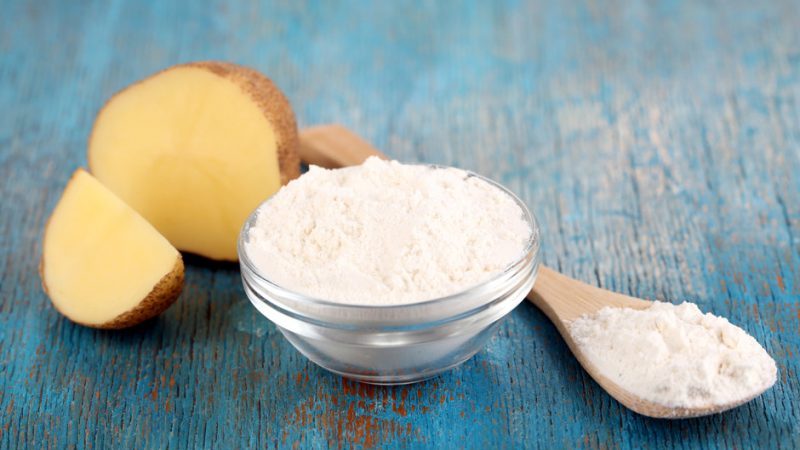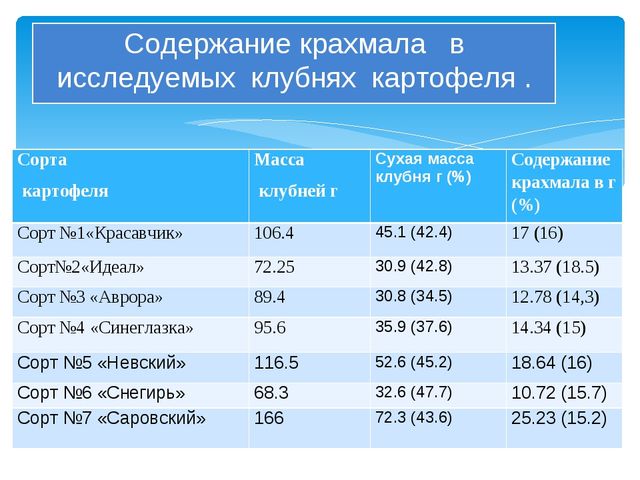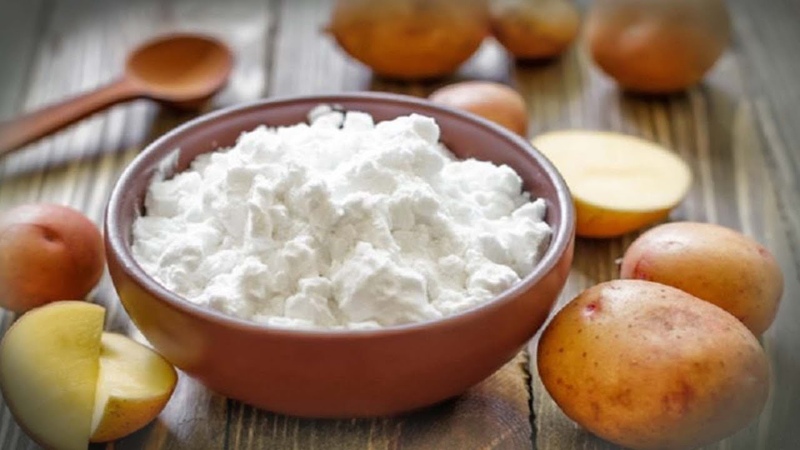How to determine the starch content of potatoes
Why is it better to make mashed potatoes from one potato, and it is better to fry the other? It's all about starch - its quantity influences the culinary choice. For this reason, some varieties of potatoes are not used at all for frying, while others are not used for industrial processing.
About properties potato starch, what its content depends on and what it affects, how to determine its quantity - you will find out in the article.
The content of the article
Properties and features
Part of the glucose formed during photosynthesis in plant organisms is converted into polysaccharides, which are called starch. These substances are stored as reserve food in tubers and fruits of some crops. The content in raw potato tuber is usually up to 30%.
Features of the structure of the polymer chain provide unique properties of potato starch:
- low temperature of gelatinization - about 60 ° С;
- high degree of swelling;
- no foam when dissolving;
- preservation of white color during long-term storage.

Receiving
The potatoes are crushed and the polysaccharides are released from the cells. Then the product is washed, dried and starch is obtained in the form of a white powder, tasteless and odorless.
Application
Potato starch is widely used in the food industry as a thickener, a component of sausages and confectionery. It is used to make glue, papermaking and fabric processing compounds.
In the manufacture of medicines, it is used as a filler or baking powder.
Benefit and harm
Starch is a valuable carbohydrate. Under the influence of digestive enzymes, the substance decomposes to glucose, which, oxidizing to carbon dioxide and water, provides the body with energy.
The product has enveloping properties, therefore starchy dishes are recommended for exacerbation of peptic ulcer disease.
Although starch is considered a complex carbohydrate, its glycemic index is quite high and is equal to 95. The thermally processed substance in the body is quickly converted almost completely into glucose. Two hours after consuming 100 g of starch, the blood sugar level will be the same as after consuming 95 g of pure glucose.
This feature of the substance is the main harm.
Abuse of foods with potato starch leads to:
- being overweight;
- increased blood sugar;
- malfunctions of the gastrointestinal tract (constipation, flatulence, belching).
What determines the starch content in potatoes
The amount of polysaccharides is not constant and varies by 5-7% depending on varietal characteristics, weather conditions, agricultural technology, yield and size of tubers.
Varietal features
Early varieties contain the least amount of starch, since the compound does not have time to accumulate in the tubers during the short growing season.
Late-ripening varieties are usually harvested unripe, and the starch content of such potatoes is also low.
Mid-season potatoes are in the lead in terms of the amount of starch. The duration of summer in most Russian regions is optimal for the accumulation of the maximum amount of polysaccharides in the tubers of such varieties.

Weather
In dry, hot and sunny weather, more starch is formed, since the processes of photosynthesis and the formation of nutrients are most intense.
The potatoes grown in the northern regions are generally less starchy. This is due to later planting and early harvesting, lower temperatures.
Agrotechnics
On light loamy soils, tubers accumulate more starch due to proper air exchange and moisture.
And the abuse of nitrogen fertilizers increases the growing season of plants and leads to a decrease in the amount of starch.
Important! To grow tasty potatoes, you need a balance of mineral fertilizers - nitrogen, phosphorus and potassium (NPK). For best results, use equilibrium brands of NPK fertilizers, for example, Nitroammofosku - 18-18-18.
Yield and size of tubers
The higher the potato yield, the less starch in the tubers.
Small and medium-sized potatoes contain more sugar than large ones.
What is the difference between high and low starch potatoes
Depending on the percentage of starch, varieties are distinguished:
- low starchy - contain 10-13%, used for salads and soups, since during cooking potatoes remain intact, do not crumble;
- medium starchy - with 13-16% starch, ideal for frying, the slices have a pleasant taste and texture and at the same time retain their shape;
- highly starchy - tubers with 16-18%, easy to boil, irreplaceable for mashed potatoes, baking, cooking;
- technical - contain over 20% polysaccharides, due to their high nutritional value, they are used as feed in animal husbandry, in the production of alcohol and starch.
How to determine the quantity
When buying potatoes, it is not always possible to recognize its variety.
It is possible to determine whether there is starch in potatoes in the amount necessary for the preparation of the intended dish at home.
Attention! Determination requires scales and volumetric dishes with an error of no more than 5 ml.
The method is based on the dependence of the density of the raw tuber on the starch content in it.
How to determine the density of a potato:
- Peel and weigh the potato. Write down the mass, it will be needed for calculations.
- Pour 1000 ml of water into a measuring container at the mark (V1).
- Submerge the weighed tuber in water and measure the level after the potato is immersed (V2).
- According to Archimedes' law, the volume of the body is equal to the volume of the displaced liquid: the volume of the tuber = V2-V1
- Calculate the density in g / cm3: divide the mass of the tuber by its volume.
Determine the starch content (A) from the table below:
| g / cm3 | AND, % | g / cm3 | AND, % | g / cm3 | AND, % |
| 1,080 | 13,9 | 1,107 | 19,7 | 1,134 | 25,5 |
| 1,081 | 14,1 | 1,108 | 19,9 | 1,135 | 25,7 |
| 1,082 | 14,3 | 1,109 | 20,1 | 1,136 | 25,9 |
| 1,083 | 14,5 | 1,110 | 20,3 | 1,137 | 26,1 |
| 1,084 | 14,7 | 1,111 | 20,5 | 1,138 | 26,3 |
| 1,085 | 14,9 | 1,112 | 20,7 | 1,139 | 26,5 |
| 1,086 | 15,1 | 1,113 | 20,9 | 1,140 | 26,7 |
| 1,087 | 15,4 | 1,114 | 21,1 | 1,141 | 27,0 |
| 1,088 | 15,6 | 1,115 | 21,4 | 1,142 | 27,2 |
| 1,089 | 15,8 | 1,116 | 21,6 | 1,143 | 27,4 |
| 1,090 | 16,0 | 1,117 | 21,8 | 1,144 | 27,6 |
| 1,091 | 16,2 | 1,118 | 22,0 | 1,145 | 27,6 |
| 1,092 | 16,4 | 1,119 | 22,2 | 1,146 | 28,0 |
| 1,093 | 16,6 | 1,120 | 22,5 | 1,147 | 28,3 |
| 1,094 | 16,9 | 1,121 | 22,7 | 1,148 | 28,5 |
| 1,095 | 17,1 | 1,122 | 22,9 | 1,149 | 28,7 |
| 1,096 | 17,3 | 1,123 | 23,1 | 1,150 | 28,9 |
| 1,097 | 17,5 | 1,124 | 23,3 | 1,151 | 29,1 |
| 1,098 | 17,7 | 1,125 | 23,5 | 1,152 | 29,3 |
| 1,099 | 17,9 | 1,126 | 23,7 | 1,153 | 29,6 |
| 1,100 | 18,2 | 1,127 | 24,0 | 1,154 | 29,8 |
| 1,101 | 18,4 | 1,128 | 24,2 | 1,155 | 30,0 |
| 1,102 | 18,6 | 1,129 | 24,4 | 1,156 | 30,2 |
| 1,103 | 18,8 | 1,130 | 24,6 | 1,157 | 30,4 |
| 1,104 | 19,0 | 1,131 | 24,8 | 1,158 | 30,6 |
| 1,105 | 19,2 | 1,132 | 25,0 | 1,159 | 30,6 |
| 1,106 | 19,4 | 1,133 | 25,2 |
Express method for determination of starch
There is not so accurate, but quite objective way. Cut the potatoes and quickly rub the halves together:
- if liquid is released, then the tubers contain a little starch and will not boil;
- if the halves stick together, the starch content is high: such potatoes will become crumbly during cooking.
High starch varieties

Table varieties containing a lot of starch are popular. Below are reviews of some of them.
Elizabeth
Medium early variety, recommended for cultivation in the North, North-West, Volgo-Vyatka, Far East regions.
The tuber is round, white. The peel is smooth, with small uncolored eyes. The pulp is white, does not darken when cut.
Potato mass from 80 to 140 g, starch content up to 18.4%.
Aurora
Mid-season potatoes, suitable for cultivation in the North, Central, Volgo-Vyatka, Middle Volga, Far Eastern regions.
The tuber is oval, with small eyes, weighing 90-120 g. The peel is smooth, with a reddish tint. The pulp is creamy, the taste is excellent. The content of starchy substances is up to 17.5%.
Zhuravinka
Recommended for cultivation in the Central region. Ripening is medium late.
The tubers are round, with a red rough skin. The pulp is light yellow. The mass of one potato is from 90 to 140 g, starch contains up to 19.6%.
Bashkir
An early ripe variety, grown mainly in the Urals. Tubers are oval-rounded, with a smooth red skin, eyes of medium depth. The pulp is white, firm. Starch content up to 19.8%.
Medium starch varieties
These varieties are used mainly for frying.
Sineglazka 2016
The variety is mid-season, recommended for cultivation in the Central region.
The tubers are oval, with eyes of medium depth. The rind is bluish, the flesh is white. Tuber weight 70-190 g. Starch contains 11-14%.
Ryabinushka
Mid-early, grown in the North, North-West, Central and Middle Volga regions.
Potatoes are rounded, with small eyes. The skin is smooth, red. The pulp is creamy. Starch content up to 16%.
Red Lady
Early ripe variety for the North Caucasus and Middle Volga regions.
Tubers are oval, elongated, with very small eyes. The peel is red, the flesh is light yellow. Starch content 13-16%. Tuber mass ranges from 100 to 140 g.
Lapis lazuli
Medium early variety, recommended for the Central Black Earth Region. Round shaped potatoes with smooth yellow skin. The pulp is white. Tuber weight 90-120 g. Starch 13.5-16.5%.
Which potatoes have the least starch
Here are some examples of popular low starch varieties.
Leader
Grown in the North-West region, early ripening, harvesting begins 45 days after germination.
The tubers are round, with small eyes. The peel is smooth, yellow. The pulp is white.
The starch content in potatoes is up to 12%.
Nevsky
Mid-earlysuitable for growing in all regions.
The tubers are light beige with white flesh. The eyes are small, pink. Tuber weight 90-130 g, starch content 10-12%.
Slav
Variety mid-season, for the Central Black Earth region.
Tubers are elongated, with small eyes. The peel is reddish, the flesh is creamy. The weight of commercial potatoes is 90-180 g, the starch content is 11-13%.
Zhukovsky early
Recommended for all regions, super early.
Tubers are pink with white flesh. The eyes are red, small. Tuber weight about 100 g, starch content 10-12%.
Conclusion
Starch is glucose converted into polysaccharides, stored as a reserve food in various parts of plants. The compound belongs to complex carbohydrates, has a high glycemic index.
Potatoes contain up to 30% starch, in table varieties - no more than 18%. The amount of starch depends on the variety, growing conditions, weather. The more it is, the more the potatoes will boil during the cooking process. It is not difficult to check the content at home - this way you will find out which dishes the purchased or grown potatoes are suitable for.